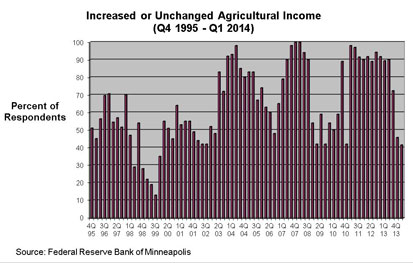Reduced crop prices and high input costs continue to take a financial toll on farmers and may be putting downward pressure on land prices heading into planting season, according to results of the Minneapolis Fed’s first-quarter (April) agricultural credit conditions survey. Farm incomes and capital spending decreased, according to lenders responding to the survey. Falling incomes haven’t had much effect on loan repayments, but renewals and extensions increased slightly, as did loan demand. Meanwhile, growth in cropland values moderated, with prices falling in some areas. The outlook for the second quarter of 2014 is downbeat, with survey respondents predicting further decreases in incomes, capital expenditures and household spending.
Farm income, household spending and capital investment
“Grain prices are lower than the previous year, and cash flow projections for 2014 indicate tighter profit margins on cash grain operations,” reported a South Dakota banker. But the picture was different for ranchers. “Livestock producers are more profitable with lower grain prices,” the contact added.
More than half of district lenders surveyed (58 percent) reported that farm incomes decreased in the third quarter of 2013 from the previous quarter, while fewer than 10 percent said that incomes increased (see chart). Household spending within the district was flat, with about three of five lenders reporting no change; slightly more noted decreases than increases. Capital spending was down almost as much as income, with 55 percent of lenders saying it decreased compared with 11 percent claiming it increased.
Likely due to strength in ranching, Montana experienced the most widespread increase in income in the district, but even there only 27 percent of respondents reported higher farm income (with the same number reporting lower income). Capital spending was also flat in Montana, but household spending increased on average. Lenders in Minnesota were the most negative, as none of those surveyed in the state reported increased incomes in the quarter. Minnesota respondents saw household and capital spending decrease the most districtwide.
Loan repayments and renewals
Even with the drop in incomes, agricultural producers in the district were maintaining their rate of loan repayments, but renewals increased slightly. Loan repayments were unchanged for 75 percent of respondents, while 13 percent reported that repayment rates decreased. A majority of lenders, 77 percent, stated that the number of renewals held steady, but 20 percent reported a higher number of renewals. Wisconsin saw the lowest rates of repayment, with one lender commenting, “[Due] to drought, crop farmers had difficultly repaying operating loans.”
Demand for loans, required collateral and interest rates
Consistent with a downturn in incomes, demand for loans rose slightly from the last survey. A quarter of lenders surveyed reported increased loan demand, while another two-thirds experienced no change. The amount of required collateral increased slightly on balance, with 92 percent of respondents reporting no change. Interest rates were little changed: Fixed rates on operating and real estate loans rose slightly on average from the previous quarter, while fixed rates on machinery loans were unchanged; variable rates increased a small amount on machinery and real estate loans, but fell slightly for operating loans.
Cash rents and land values
After several years of very strong growth, land prices have moderated in recent surveys, a trend that continued in the first three months of 2014. Values even decreased in some cases, along with cash rents. The average value for nonirrigated cropland in the district fell by almost 2 percent from the first quarter of 2013; irrigated land fell slightly (by less than 1 percent), while ranchland values increased nearly 8 percent, likely owing to solid livestock prices. The district average cash rent for nonirrigated land fell more than the value, by almost 4 percent from a year ago. Rents for irrigated land increased less than a percent, while ranchland rents rose by 4 percent.
The picture was mixed across the district. Values fell the most in Minnesota, where nonirrigated cropland prices dropped 8 percent compared with a year earlier, according to survey respondents. Nonirrigated Minnesota cropland prices dropped nearly 10 percent, and ranchland values rose 3 percent, while rents fell for both classes of cropland and increased for ranchland. Price appreciation generally continued in other states, but at a slower rate than the double-digit growth of recent years—Montana, the Dakotas and Wisconsin each saw nonirrigated land values rise by less than 10 percent. However, nonirrigatel cropland rents fell by 5 percent in North Dakota and 2 percent in South Dakota.
Outlook
Expectations heading into the growing season are slightly pessimistic, generally. Across the district, 53 percent of lenders predicted that farm income will decrease in the second quarter of 2014, compared with 8 percent forecasting increases. The outlook for household spending is slightly better, with 30 percent expecting decreases, while 57 expect capital spending to fall. Loan demand was generally forecast to rise in the upcoming quarter (40 percent expect increases), while the outlook for repayments, renewals and collateral requirements is mostly flat.
As always, the outlook is heavily dependent on the weather. As one Minnesota lender commented ominously, “Harsh winter and cold spring are bringing concerns about a late planting season. Reduced crop prices and high input/cash rent [costs are] also very concerning.”
Percent of respondents who reported decreased levels for the past three months compared with the same period last year:
| MN |
MT |
ND |
SD |
WI |
Ninth District |
|
| Rate of loan repayments | 21 |
- |
5 |
7 |
43 |
13 |
| Net farm income | 76 |
27 |
52 |
52 |
57 |
58 |
| Farm household spending | 62 |
- |
19 |
21 |
29 |
23 |
| Farm capital spending | 74 |
18 |
57 |
45 |
43 |
55 |
| Loan demand | 24 |
- |
5 |
10 |
14 |
13 |
Percent of respondents who reported increased levels for the past three months compared with the same period last year:
| MN |
MT |
ND |
SD |
WI |
Ninth District |
|
|---|---|---|---|---|---|---|
| Loan renewals or extensions | 26 |
9 |
33 |
3 |
29 |
20 |
| Referrals to other lenders | 3 |
- |
- |
- |
- |
1 |
| Amount of collateral required | 8 |
9 |
5 |
10 |
- |
8 |
| Loan Demand | 29 |
9 |
14 |
31 |
29 |
25 |
Note: The Upper Peninsula of Michigan is not part of the survey.
Percent of respondents who expect decreased levels for the next three months:
| MN |
MT |
ND |
SD |
WI | Ninth District |
|
|---|---|---|---|---|---|---|
| Rate of loan repayments | 24 |
- |
5 |
11 |
29 |
15 |
| Net farm income | 63 |
27 |
52 |
55 |
57 |
53 |
| Farm household spending | 32 |
- |
19 |
24 |
29 |
23 |
| Farm capital spending | 74 |
9 |
57 |
55 |
43 |
57 |
| Loan demand | 18 |
10 |
- |
7 |
- |
10 |
Percent of respondents who expect increased levels for the next three months:
| MN |
MT |
ND |
SD |
WI |
Ninth District |
|
|---|---|---|---|---|---|---|
| Loan renewals or extensions | 13 |
- |
25 |
4 |
43 |
14 |
| Referrals to other lenders | - |
- |
- |
4 |
- |
1 |
| Amount of collateral required | 5 |
- |
10 |
3 |
- |
5 |
| Loan Demand | 34 |
20 |
37 |
48 |
71 |
40 |
Note: The Upper Peninsula of Michigan is not part of the survey.
Appendix:
Joe Mahon is a Minneapolis Fed regional outreach director. Joe’s primary responsibilities involve tracking several sectors of the Ninth District economy, including agriculture, manufacturing, energy, and mining.






